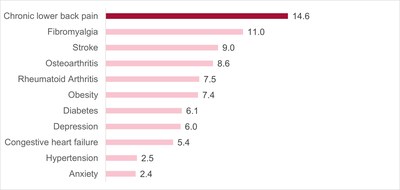Landmark Survey by Stagwell's The Harris Poll Estimates More Than 72.3 Million U.S. Adults Suffer from Chronic Low Back Pain - Greater than Arthritis, Diabetes, or Heart Disease and with Debilitating Impact on Quality of Life
- Significant Drop in Mobility Due to Chronic Low Back Pain (CLBP) Demonstrated in New Mobility Index, with Highest Drop Among Those in Their 50s
- Treatment is Deficient with
15% Currently Taking Opioids Despite CDC Guidelines Noting Inadequate Effectiveness and Inherent Risks - Only
5% Utilizing Recommended Minimally Invasive Treatment Options
NEW YORK, Aug. 9, 2022 /PRNewswire/ -- The Harris Poll, a Stagwell (NASDAQ: STGW) agency, announced today complete results from a landmark survey, "Mobility Matters: Chronic Low Back Pain in America," sponsored by Vertos Medical as part of its national health awareness campaign, Know Your Back Story. The nationally representative survey estimates that more than 72.3 million U.S. adults –
Other key findings (Click here for Executive Summary and here for Presentation) include:
CLBP Has Significant Impact on Mobility and Long-term Negative Impact on Life
- More than half (
53% ) say CLBP has had a major or moderate negative impact on their quality of life - More than one third of CLBP sufferers (
36% ) report their CLBP is "severe", "very severe", or the "worst pain possible" 44% report that they've been experiencing CLBP for 5 years or more- New Mobility Index, based on survey data, shows significant drop (~20 points on a scale of 0 to 100) in CLBP sufferers' ability to move, with the highest drop seen among those in their 50s
Lack of Knowledge About CLBP Causes and Need for Better Treatment Options and Hope
- More than one-third of CLBP sufferers (
37% ) have never been told by a healthcare professional what causes their CLBP, despite86% strongly or somewhat agreeing that it is important to know the specific cause so their CLBP can be managed effectively - Only 2 in 5 (
39% ) have ever been told that CLBP can be caused by lumbar spinal stenosis (LSS), a condition often caused by an enlarged ligament compressing spinal nerves8 - Four out of 5 CLBP sufferers (
82% ) experience at least one symptom consistent with LSS, yet nearly 4 out of 5 (78% ) do not know an enlarged ligament can cause CLBP - The vast majority (
84% ) say they wish there were better treatment options for their CLBP 78% have accepted CLBP as part of their life, despite treatment advances that might help address the cause of CLBP
"These survey results demonstrate that people with chronic low back pain are suffering greatly over long periods of time, and many have resigned themselves to living in a debilitated state," said Kathy Steinberg, Vice President of Media and Communications Research at The Harris Poll. "The fact that more than a third are not being told what is causing their pain, such as LSS or an enlarged ligament, makes it more difficult to treat that pain. It is also alarming that opioid use is still high in people with back pain while other treatments such as minimally invasive procedures are not playing more of a role given the latest treatment guidelines.7 Taken together, these findings suggest more awareness is needed to help people determine the cause of their pain and an appropriate treatment regimen to help them find relief."
Mobility Index and Findings
The landmark survey data was also used to generate a Mobility Index, based on survey participants' ratings of their overall mobility; ability to do specific physical activities; and level of agreement with statements about mobility, pain, physical limitations, and ability to complete everyday tasks. The scores on the individual items were combined so that the Mobility Index ranged from zero (no mobility) to 100 (the highest level of mobility).
The overall results show that the average Mobility Index is 57.0 for CLBP sufferers vs. 76.4 for adults without CLBP. This approximate 20-point difference is consistent across most decade age groups, with the highest drop among those in their 50s, underscoring that this debilitating disease progresses with age and the importance of early intervention. Further, Harris Poll ran step-wise regression to isolate the individual impacts of nearly a dozen common chronic diseases (e.g., obesity, diabetes, osteoarthritis, rheumatoid arthritis, and stroke), and CLBP was the leading cause of reduced mobility (see chart above; See also Full Report here). As indicated in the chart above, individuals with CLBP have their Mobility Index score reduced by almost 15 points solely due to their chronic low back pain, meaning that, of the 20-point gap in Mobility Index between those with CLBP and those without CLBP, nearly 15 points is due to CLBP alone.
"As people age, it can be difficult to assess what mobility challenges are a normal part of aging or a condition that may be treatable, such as chronic low back pain," said Peter Pryzbylkowski, MD, a contributor to the Mobility Matters Survey and Board Certified Pain Specialist and Anesthesiologist from Relievus Pain Management. "People with CLBP can visit knowyourbackstory.com to learn more about their condition and the Mobility Index. An especially important step is to see a spine health physician to decide on a treatment plan and get moving again."
Methodology for Mobility Matters: Chronic Low Back Pain in America and the First-Ever Mobility Index
The Mobility Matters: Landmark Survey on Chronic Low Back Pain in America and Mobility Index was conducted online in the United States by The Harris Poll on behalf of Vertos Medical among 5,020 adults ages 18+, including 1,521 adults who currently experience chronic low back pain and/or sciatic pain, i.e., back pain that runs into the hips and legs ("CLBP sufferers"). The survey was conducted May 12 – May 20, 2022. Data were weighted where necessary by age, gender, race/ethnicity, region, education, household income, household size, and marital status to bring them in line with their actual proportions in the U.S. adult population, allowing estimates of the prevalence and magnitude of survey responses to be extrapolated to this population.
Respondents for this survey were selected from among those who have agreed to participate in our surveys. The sampling precision of Harris online polls is measured by using a Bayesian credible interval. For this study, the sample data are accurate to within +/- 1.7 percentage points using a
About The Harris Poll
The Harris Poll is a global consulting and market research firm that strives to reveal the authentic values of modern society to inspire leaders to create a better tomorrow. It works with clients in three primary areas: building twenty-first-century corporate reputation, crafting brand strategy and performance tracking, and earning organic media through public relations research. One of the longest-running surveys in the U.S., The Harris Poll has tracked public opinion, motivations and social sentiment since 1963, and is now part of Stagwell, the challenger holding company built to transform marketing.
About Stagwell
Stagwell is the challenger network built to transform marketing. We deliver scaled creative performance for the world's most ambitious brands, connecting culture-moving creativity with leading-edge technology to harmonize the art and science of marketing. Led by entrepreneurs, our 13,000+ specialists in 34+ countries are unified under a single purpose: to drive effectiveness and improve business results for their clients. Join us at www.stagwellglobal.com.
About Vertos Medical, Inc.
Vertos Medical Inc. is a medical device company committed to developing innovative, minimally invasive treatments for lumbar spinal stenosis (LSS). mild®, its proprietary technology, is a safe and minimally invasive outpatient procedure designed to restore space in the spinal canal through an incision smaller than the size of a baby aspirin. Learn more at www.Vertosmed.com.
References
1 Meucci RD, Fassa AG, Faria NM. Prevalence of chronic low back pain : systematic review. Rev Saude Publica. 2015;49:1. doi:10.1590/S0034-8910.2015049005874
2 Shmagel A, Foley R, Ibrahim H. Epidemiology of Chronic Low Back Pain in US Adults: Data From the 2009-2010 National Health and Nutrition Examination Survey. Arthritis Care Res (Hoboken). 2016;68(11):1688-1694. doi:10.1002/acr.22890
3 Barbour KE, Helmick CG, Boring M, Brady TJ. Vital Signs: Prevalence of Doctor-Diagnosed Arthritis and Arthritis-Attributable Activity Limitation—United States, 2013–2015. Morb Mortal Wkly Rep 2017;66:246–253. doi: 10.15585/mmwr.mm6609e1.
4 Centers for Disease Control and Prevention. National Diabetes Statistics Report. Available: https://www.cdc.gov/diabetes/data/statistics-report/index.html. Accessed June 18, 2022.
5 HealthLine. Heart Disease: Facts, Statistics, and You. Available: https://www.healthline.com/health/heart-disease/statistics#Who-is-at-risk?. Accessed June 18, 2022.
6 Centers for Disease Control and Prevention. Acute low back pain. Available: https://www.cdc.gov/acute-pain/low-back-pain/index.html. Accessed July 21, 2022.
7 Deer TR, Grider JS, Pope JE, et al. Best Practices for Minimally Invasive Lumbar Spinal Stenosis Treatment 2.0 (MIST): Consensus Guidance from the American Society of Pain and Neuroscience (ASPN). J Pain Res. 2022;15:1325-1354. Published 2022 May 5. doi:10.2147/JPR.S355285
8 Hansson T, Suzuki N, Hebelka H, Gaulitz A. The narrowing of the lumbar spinal canal during loaded MRI: the effects of the disc and ligamentum flavum. Eur Spine J. 2009;18(5): 679-686. Doi:10.1007/s00586-009-0919-7.
CONTACT:
Sarah Arvizo
pr@stagwellglobal.com
![]() View original content to download multimedia:https://www.prnewswire.com/news-releases/landmark-survey-by-stagwells-the-harris-poll-estimates-more-than-72-3-million-us-adults-suffer-from-chronic-low-back-pain--greater-than-arthritis-diabetes-or-heart-disease-and-with-debilitating-impact-on-quality-of-life-301602566.html
View original content to download multimedia:https://www.prnewswire.com/news-releases/landmark-survey-by-stagwells-the-harris-poll-estimates-more-than-72-3-million-us-adults-suffer-from-chronic-low-back-pain--greater-than-arthritis-diabetes-or-heart-disease-and-with-debilitating-impact-on-quality-of-life-301602566.html
SOURCE Stagwell Inc.









